
Prescience and OODA Loops: Navigating the Chaos of Grappling
In the sci-fi masterpiece Dune, the protagonist Paul Atreides gains the power of prescience, the supernatural ability to see the future. In his prescience, he does not see a single vision of one future, but many potential futures -- where the most probable ones are clearly defined, and outliers are hazy or occluded. As the story’s main character and, ultimately, the God-Emperor of a galaxy-spanning civilization, his mission is to navigate all the conflicts and betrayals around him to steer humanity towards its best future.
Prescience may be fantasy, but in it is a useful way of thinking about how we make decisions as in grappling, and help us dispel some myths, like the common belief that black belts are thinking 100 moves ahead.
The Dune books describe presciene as riding the waves of history, or climbing hills to see what’s ahead before descending into the valleys: sometimes being lifted up by significant events to clearly see what possibilities lay before him, but at other times being brought down by the uncertainty of unpredicted surprises and being limited to the immediate now. Much of the tension of the story comes from Paul making decisions and acting in the moments when the future is uncertain, but he holds true to his vision for the future he wants to see made real.
The parallel to draw in grappling is that while we cannot know every possible thing that can happen to us in a match, we can know our desired outcomes, and we can act in each moment to increase the likelihood we arrive at them.
Here are the kind of questions you are trying to answer and act on throughout a match:
- Where are we now -- what position is this?
- Where do I want to be next? What is stopping me?
- What do they seem to want to do? Can I stop them?
- What danger am I in?
- What other options do I have?
- Things have changed -- what now?
More specific examples:
- Where are my hands, feet, etc.? What are their grips, etc.?
- How is my balance? How is their balance?
- What do they keep looking at or reaching for -- is it a tell?
- Do I know they like a certain move? Can I prevent or counter it?
Those questions are not something you usually consciously run through. Actions and reactions happen too fast for that, unless you get to a stalemate or secure a safe position to catch your breath. You should be experienced enough to be answering those questions almost automatically so you can act without hesitation.
How you answer those questions depends on you and your past experiences and training, and those of your opponent.
- You know your favorite moves and how you like to initiate.
- You know how you like to finish matches.
- You know what you want out of the current situation and what they will likely lead to.
- You have a sense of what your opponent wants, and you take precautions to defend against them. Maybe you’ve gone against them before or scouted their other matches.
- You weigh the risk-to-reward ratio for each action, tending towards safer bets, but also looking for sudden opportunities to strike upon.
Leaving the world of science fiction, we can turn to the Air Force’s fighter pilot training for a tool that explains critical decision making called the OODA loop. OODA stands for:
- Observe
- Orient
- Decide
- Act
Anyone with military training has probably heard “OODA” or “getting inside the enemy’s loop” countless times, and the idea has been brought into business, law, and other decision-filled fields.
What the creator of the OODA loop recognized is that conflicts are always evolving, and that you need a way to resolve them that can quickly adapt to changing conditions and new information. Most of the questions I posed above (e.g. “what grip do they have?”) fall into the Observe step. The next three parts of the cycle are what you do with that observation. Proponents of this system emphasize the importance of having a rapid OODA loop, so you are cycling through it faster than your opponent, so they are acting too late or failing to take new factors into consideration.
Whether through consuming a sandworm’s spice melange to gain supernatural prescience, or the more mundane but applicable OODA loop, your grappling will improve when you recognize the utility of a decision-making process that helps you navigate the chaotic present to arrive at your desired futures.
Other articles:
Quick links
Contact us
About us
Quality BJJ gear at fair prices, available all year. Founded in 2012 to provide an alternative to high-cost, limited edition gis. Dive into the BJJ lifestyle with us—join the Panda Nation!"
